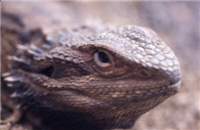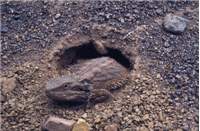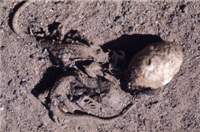Family
Agamidae (dragons)
Genus
Pogona
Species
barbata
Threats/Control Methods - Regional
Bearded Dragons are often run over while sunning themselves on roads, especially during spring.
Threats/Control Methods - Local
The expansion of urban areas into previous habitat is a potential threat to local populations of Bearded Dragons. Pets and feral animals also pose a threat to Bearded Dragons.
Local/Urban Actions
Maintaining or improving suitable habitat (such as fallen timber) in nature reserves by not collecting larger timber for firewood is one action that can be taken by residents of urban Canberra.
Common name/s
Common Bearded Dragon, Eastern Bearded Dragon, Jew Lizard
Distinguishing Features
The Bearded Dragon is a large lizard, sometimes growing to over 50cm, averaging around 40cm. The most obvious feature is its extendable throat which looks like a beard. They are grey to brown in colour with only faint markings (except on juveniles which have pale blotches on each side of the back). The interior of the mouth is yellow. The dragon has spines on the back of the head, on the beard and running down the side of the body. The body is short, while the tail is very long.
Similar Species
The Central Beared Dragon (Pogona vitticeps) is similar in appearance, but it is more robust than the Common Bearded Dragon, and the row of spines on the side of the body continues over the front leg. Usually species can be differentiated by their different ranges: the Central Bearded Dragon occurs further west, in more arid areas, it doesn't occur in the ACT.
Distribution
The Bearded Dragon occurs mostly on the slopes of the Great Dividing Range, from northern Queensland, through NSW and Victoria. The Bearded Dragon also extends into the southern parts of South Australia. The Bearded Dragon is commonly seen around the rural areas of the ACT and surrounds.
Country of Origin
Australia
Survey Techniques
Pitfall trapping and hand searching
Conservation (Pet/Pest) Status - National
Not listed as threatened under the EPBC act
Conservation (Pet/Pest) Status - Regional
Bearded Dragons are listed as exempt under the Nature Conservation Act 1980 and may be kept by hobbyists with no prior experience of keeping lizards (see Reptile Policy).
LSCCES Population
Not commonly seen in urban Canberra.
Associated vegetation community
Woodlands and dry sclerophyll forests.
Limiting Resources
The main limiting resources for Bearded Dragons in urban ACT are suitable intact habitat areas.
Breeding
Bearded Dragons breed in late spring to summer. They dig a tunnel in which the females will lay up to 30 eggs. After laying, the tunnel is then filled. Bearded Dragons may produce two clutches of eggs in the one season.
Behaviour
Bearded dragons are diurnal, and are often seen perching on logs, stumps and fence posts. They seek shelter in trees and under logs.
Functional Group
Omnivore
Food Species
Grasshoppers, beetles, moths and other invertebrates. Fruits and vegetable matter are also eaten.
Predators
The Common Bearded Dragon is preyed upon by cats and dogs. Juveniles of the species are sometimes taken by snakes.
Interesting Fact
When threatened the bearded dragon extends its beard, flattens its body and opens its brightly coloured mouth.
References - (reader suitability of references, P=Primary teachers, S=Secondary students, T=Tertiary students and researchers)
Books:
Bennett, R. 1997. Reptiles & frogs of the Australian Capital Territory. National Parks Association of the ACT, Woden. S
Cogger, H.G. 1996. Reptiles and Amphibians of Australia. Reed Books Australia, Melbourne.
Wilson, S. and Swan, G. 2003. A Complete Guide to Reptiles of Australia. Reed New Holland, Sydney. S, T
Online Publications:
Abell-Davis S. 2000. "Pogona Barata"http://www.jcu.edu.au/school/tbiol/zoology/herp/Pogonabarbata.PDF[Last accessed 4/4/07]
Researchers: Ian Rayner and Adam Houlden



 Top
Top Top
Top